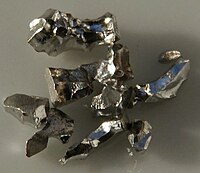
Photo from wikipedia
PURPOSE The purpose of this study is to explore the feasibility of the use of titanium fiducial markers to minimize the metallic artifact seen with tantalum markers which causes significant… Click to show full abstract
PURPOSE The purpose of this study is to explore the feasibility of the use of titanium fiducial markers to minimize the metallic artifact seen with tantalum markers which causes significant distortion on postoperative orbital CT scans. METHOD We designed and constructed the titanium markers in the shop of Crocker Nuclear Laboratory, UC Davis, CA. The markers were placed on an eyeball phantom. The eyeball was inserted into the Rando phantom in the orbital space. The Rando phantom was imaged with coplanar x rays on Nucletron simulator at UCSF, on digital panel on the eye beam line at CNL eye treatment facility and on CT scanner at UCSF. RESULTS The titanium markers can be clearly seen on the hard copy of x rays and on digital panel. The CT scan of an orbit using tantalum markers on the right eye and titanium markers on the left eye shows the metal artifact from tantalum markers. Titanium markers show very little distortion on CT images. CONCLUSION The present study describes these markers and their relative benefit in comparison with tantalum marker, which has been used for localizing ocular tumor for decades.
Journal Title: Medical Physics
Year Published: 2018
Link to full text (if available)
Share on Social Media: Sign Up to like & get
recommendations!